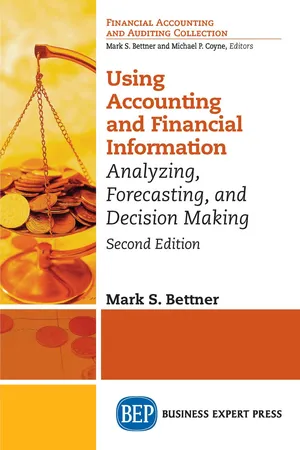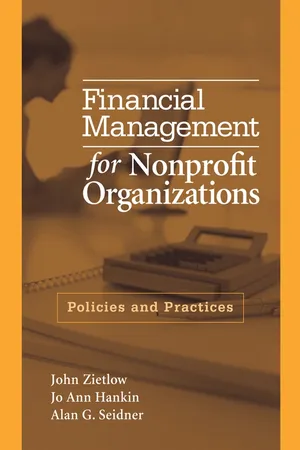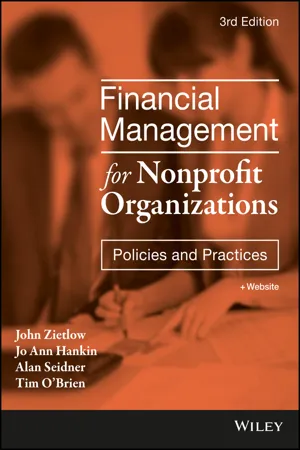Business
Long Term Financial Plans
Long term financial plans are strategic roadmaps that outline a company's financial goals and the steps needed to achieve them over an extended period, typically spanning several years. These plans encompass budgeting, investment strategies, capital structure decisions, and financial risk management to ensure the company's long-term sustainability and growth.
Written by Perlego with AI-assistance
Related key terms
7 Key excerpts on "Long Term Financial Plans"
- eBook - ePub
- Keith Ward(Author)
- 2013(Publication Date)
- Routledge(Publisher)
Planning consists of deciding what to do and how to do it, and involves reallocating resources and removing constraints. Planning is, therefore, decision-based.It forces the business to set itself objectives which define what it is trying to do and then to establish strategies and tactics to achieve these objectives. Financial analysis is fundamental to ensuring that the objectives are practical and attainable and that the most appropriate strategy is adopted. This requires the business to choose among alternatives and the best way to do this is to evaluate the opportunity cost of the alternatives.Financial decision-making only involves future costs and benefits, and any ‘sunk’ costs can be ignored, which makes the decision more dependent on managerial judgement regarding these future costs and benefits.Most businesses face a conflict between short-term benefits and long-term objectives of the business, and the planning process must take account of this. Many companies try to resolve this by integrating the short-term planning process (the budget) within the long-range corporate plan so that the two share the same overall objectives.We now examine these aspects of planning in detail in Chapters 7 and 8 , before considering the financing requirements of the future plans in Chapter 9 .Passage contains an image 7
Long-term planningIntroductionOnce the business has agreed its mission statement, the long-term planning process must set out how the mission is to be fulfilled. In the long term it is possible for a company to plan to change existing allocations of resources and to remove current constraints, such as lack of access to distribution channels, on the business even if such changes will take time to achieve. This is the most fundamental difference between long-term (strategic) planning and short-term (tactical) budgeting. In a plan for the next 12 months it will be impossible to make fundamental changes to many aspects of marketing strategy as the time needed to effect changes (the lead time) is greater than the 12-month planning period. If the corporate objective for growth can only be attained by launching new products, the level of this growth will be constrained by the time-scale of product developments and this may preclude any significant new product launches in the next 12 months. For longer-term plans, the company could increase the resources dedicated to product development so that these time-scales may be reduced, or it could examine the potential for buying in new products from other companies, etc. as ways of removing the constraint to growth. - eBook - ePub
- Mark S. Bettner(Author)
- 2018(Publication Date)
- Business Expert Press(Publisher)
Managers and other internal decision makers rely heavily upon long-term forecasts. Long-term projections are instrumental when planning investing activities, such as those related to fixed asset growth, equipment replacements, and capital leasing arrangements. They enable managers to budget for changes in technology, plan for product line diversification, and orchestrate mergers with—or acquisitions of—other companies. Long-term financial forecasts also assist managers as they grapple with complex workforce decisions, including pension fund structuring, early retirement incentives, downsizing, and the possibility of offshore manufacturing. Moreover, they are used to plan for, and to analyze, a variety of long-term financing decisions, such as the timing of an initial public offering, the issuance of bonds, or the refinancing of a mortgage.External stakeholders also engage in long-term financial forecasting. Investors are keenly interested in the timing, amounts, and uncertainties about a corporation’s future dividend activity. Long-term dividend projections—in conjunction with various other forecasted data—are used to discern whether the current price of a company’s stock is realistic and to make informed predictions about its future growth potential. Creditors also engage in long-term financial forecasting to predict anticipated changes in a company’s capital structure, assess a borrower’s debt servicing potential, analyze probabilities of default, and negotiate troubled debt restructuring arrangements.Long-term financial forecasts typically do not focus upon detailed operating activities such as accounts receivable collection schedules, raw materials acquisition plans, weekly production level targets, or other issues related to working capital management. These are short-term forecasting concerns that will be addressed in Chapter 6 - eBook - ePub
Financial Management for Nonprofit Organizations
Policies and Practices
- John Zietlow, Jo Ann Hankin, Alan Seidner(Authors)
- 2011(Publication Date)
- Wiley(Publisher)
The financial manager may also assist in the development of program advocates within the funding sources. The idea here is to procure some stability over the funding source. By demonstrating how the source’s funding is critical to a program’s long-range financial viability, the organization may be able to gain a deeper, more permanent degree of commitment.The final duty is budgeting. Financial managers have primary responsibility for the budget process. Our concern here is to ensure that programming decisions are translated into budget line items. (Chapter 8 is dedicated largely to budgeting.) Ideally, as each year progresses, last year’s strategic and long-range financial plan becomes the starting point not only for the new strategic and long-range financial plan, but also for the development of next year’s operating and capital budget. A warning signal emerges when the long-range financial plan is not used to help develop budgets. Possibly it is too inaccurate, or the organization is unaware of the tie between programming and budgeting. Obviously, those organizations updating long-range plans less frequently than yearly have less direct correspondence between plans and budgets. Plans are most likely to be implemented when they drive the resource allocation embodied in the annual operating and capital budgets. Finally, the process of planning is invaluable, forcing discussion and resolution of the trade-offs and prioritization involved in spending decisions.9.4 CAPITAL BUDGETING: FINANCIAL EVALUATION OF PROJECTS THAT ARISE FROM EXISTING PROGRAMS
Programs spawn projects, and these projects often involve large capital allocations with multiyear cash flow effects. These will affect your organization’s target liquidity level for years to come. Consequently, the next key question when evaluating a capital project is: Will the capital expenditure cover all of its costs and - eBook - ePub
Financial Management for Nonprofit Organizations
Policies and Practices
- John Zietlow, Jo Ann Hankin, Alan Seidner, Tim O'Brien(Authors)
- 2018(Publication Date)
- Wiley(Publisher)
Financial managers have primary responsibility for the budget process, with approval authority resting with the board. Our concern here is to ensure that programming decisions are translated into budget line items. (Chapter 8 is dedicated largely to budgeting.) Ideally, as each year progresses, use last year's strategic and long-range financial plan to be the starting point not only for the new strategic and long-range financial plan, but also for the development of next year's operating and capital budget. Consider it a warning signal when the long-range financial plan is not used to help develop budgets. Possibly the plan is too inaccurate, or the organization is unaware of the tie between programming and budgeting. Obviously, those organizations updating long-range plans less frequently than yearly have less direct correspondence between plans and budgets. Plans are most likely to be implemented when they drive the resource allocation embodied in the annual operating and capital budgets. Finally, the process of planning is invaluable, forcing discussion and resolution of the trade-offs and prioritization involved in spending decisions. 9.4 CAPITAL BUDGETING: FINANCIAL EVALUATION OF PROJECTS THAT ARISE FROM EXISTING PROGRAMS Programs spawn projects, and these projects often involve large capital allocations with multiyear cash flow effects. These will affect your organization's target liquidity level for years to come. Consequently, the next key question when evaluating a capital project is: Will the capital expenditure cover all of its costs and provide an adequate return on invested capital? This is a pivotal question for evaluating capital expenditures that bring in revenues as well as for selecting between alternative expenditures that involve only costs. Even donative nonprofit organizations may have to consider both capital expenditure types. Any expenditures bringing in multiyear cash revenues should be evaluated in the way we show next - eBook - ePub
- Toyohiro Kono(Author)
- 2016(Publication Date)
- Routledge(Publisher)
four important factors mentioned above. The follow-up of planning by top management is one of the approaches. In one pharmaceutical company, the actual implementation of a long-range plan is translated into numerical points. The level of achievement is expressed by the number of points each department has obtained, and it is made public quarterly. This point is not related to the financial reward of the head of the department, but the publication itself is a strong stimulus to implementation. In order to avoid setting easy-to-implement low targets, the actual results are not only compared with the plan, but also with the performance of the previous year.9.11 Summary
Long-range planning is a formal system used to improve strategic decisions. With long-range planning the company can collect strategic information, can find long-term opportunities and threats and can prepare for future long-term projects now. By long-range planning, the company can also integrate a number of projects, and can allocate limited resources in the most effective way. In other words, the company can make strategic decisions using the 'innovative and analytical mode' (see Table 8.10 ).Long-range planning is widely used among Japanese large corporations, with more than 70 per cent of them having the system. This is evidence that the Japanese corporation is long-term oriented.The system of long-range planning of Japanese corporations is not necessarily sophisticated. The planning systems of many successful US corporations, such as General Electric, is much more refined. Some Japanese systems consist mostly of numbers, and others consist only of basic strategies. But the trend is from quantitative plan to more strategic plan including both strategies and financial numbers. The author maintains that even if the system is not very sophisticated, long-range planning itself gives a great stimulus to long-term orientation and to strategy orientation. - eBook - ePub
Start-Up Guide for the Technopreneur
Financial Planning, Decision Making, and Negotiating from Incubation to Exit
- David Shelters(Author)
- 2012(Publication Date)
- Wiley(Publisher)
Chapter 4Financial Planning for Maximizing Returns
Having a financial strategy and a plan to execute it based on the fundraising stages is mandatory for every entrepreneurial venture seriously interested in achieving a successful exit. Too often I witness start-ups with elaborate, well-thought-out plans on how to develop, produce, market, and service their product through commercial launch and beyond. However, they fully intend to proceed without formulating some form of financial strategy or plan. Financial planning, at least on a preliminary level, is necessary initially to determine whether you have a potential viable business. Conducting effective business planning requires an informed understanding of what is and is not financially feasible in regard to your venture. To execute your business plans requires money. Without securing sufficient funds on acceptable terms and in a timely manner, every other focus of your business efforts is moot. A financial plan serves as a basis to calculate an acceptable return on investment (ROI) and determine a successful exit strategy. A financial plan with well-defined financial objectives is a must.This chapter begins with a descriptive listing of the various benefits of formulating a financial strategy and plan for your business. Then we focus on thinking strategically in devising a financial plan, including an illustrative analogy. We then turn to the areas serving as a basis for establishing financial objectives. We introduce FREEs—fundraising effectiveness and efficiencies—on both macro and micro levels and the conceptual methods of FREE measurements before we proceed to examine the construction of an effective financial plan. The chapter concludes with some rules of thumb regarding financial planning. - eBook - ePub
- David Butler(Author)
- 2006(Publication Date)
- Routledge(Publisher)
Planning and Managing the Business Finances
DOI: 10.4324/9780080462851-10Financial Planning
Financial planning is a fairly generic term which covers a range of different activities, from the initial estimating of resource requirements and associated costs, forecasting sales revenue, identifying on-going operating costs, and preparing the budgetary plans which combine the former information. It also involves cash-flow forecasting to ensure that there are no gaps between income and expenditure, analysing break-even levels, and forecasting profits.It is because the process draws together all of the other aspects of planning the business, and then expressing those plans in monetary form, that it is so important to prepare correctly, as it is the primary point of interest for bankers and any other potential lenders or investors, and is usually the first thing they will focus on when reading a business plan. If the financial forecasts do not look to be sufficiently detailed or realistic then it is highly likely that the business plan will be rejected or at least referred back for more information.The objective of this chapter is to describe the various processes involved, and the reasoning behind them, so that the reader is in a position to prepare the necessary information for his or her own business plan, in particular the budgetary plan, cash-flow forecasts, and break-even analysis. As part of the process we shall also be defining and explaining some of the financial terminology which it is essential for the owner-manager to understand.
Index pages curate the most relevant extracts from our library of academic textbooks. They’ve been created using an in-house natural language model (NLM), each adding context and meaning to key research topics.






